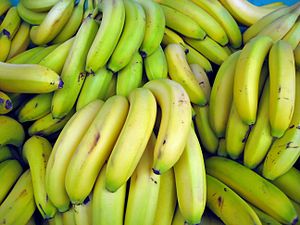This article originally appeared in the January/February 2013 issue of Foodie News, brought to you by the Public Relations Department of the American Farm Bureau Federation.
Foodie News: Tell us a little about Lago Farms.
Larsen: We farm 2.5 acres, growing primarily mini bananas but also just getting started with a few hundred pineapple plants. Many people don’t realize it, but there are about 500 acres of bananas grown in Florida. There are a lot of farmers in the state growing bananas on just a few acres.
Foodie News: Have you seen more sales and interest in mini bananas recently?
Larsen: Yes, we’re seeing more interest all the time as the Hispanic and Latino population continues to grow. The mini bananas we grow are very similar to those grown in Latin American countries.
Foodie News: How do you market your bananas?
Larsen: Farmers’ markets are where we sell most of our bananas. We harvest nearly year-round and sell them by the hand (cluster) for $1 each, which comes out to around $1 per pound. That’s a good price. When people try our mini bananas, they like them and they keep coming back to buy more. Some of our bananas are distributed through Community Supported Agriculture subscriptions.
Foodie News: Is there anything special or challenging about growing mini bananas as a crop?
Larsen: The weather is always a big concern especially cold snaps. Growing bananas is also very labor-intensive and includes harvesting just about every week, even in the winter (although production slows down). One person can probably handle up to about 5 acres, after that you would need some additional help to manage the crop. There’s not a lot of information available about how to grow mini bananas, so you have to search on your own to find solutions sometimes. Plus, with a crop grown on just a few acres, everything is done on a smaller scale, so that can be a challenge when it comes to sourcing supplies such as banana boxes. The minimum order you have to place with most box companies is 2,000 and I might use that many in a year. It’s a big cost outlay all at once.
Foodie News: The average American eats about 25 pounds of bananas each year. Do you and your family eat a lot of mini bananas?
Larsen: I would say we eat more bananas than the average family, but I’m not sure exactly how much.
Foodie News: Any closing thoughts about mini bananas?
Larsen: Mini bananas are sweeter than regular bananas and the texture is denser. They also don’t turn brown as quickly as larger bananas, which can be an advantage when appearance is important, such as when making pudding.
Foodie News: How can our readers learn more about specialty fruit or mini bananas?
Larsen: Visit the Specialty Fruit Growers of South Florida website for information about specialty fruits including mini bananas.
Larsen is a senior biological scientist specializing in entomology at the University of Florida’s Everglades Research & Education Center. He’s active in Florida Farm Bureau’s Young Farmers and Ranchers Program.


